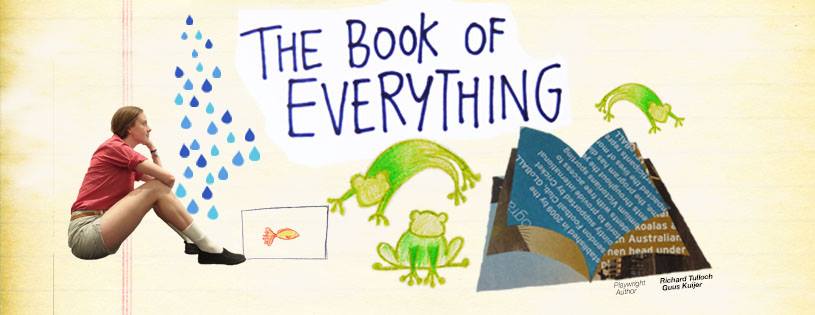The Book of Everything is a tale about an imaginative young boy, Thomas (played by Erin Nicholson). He’s a part of a dysfunctional Protestant family of four. His father (Lachie Ince) is a fundamentalist and social outcast who beats his wife and Thomas. Here you will see the detailed description. Thomas is distant from his controlling father and is constantly asking questions, believing he can see things no one else can. I’m not familiar with this story, and had little idea what to expect other than a straight play apparently adapted from a modern children’s novel. The writing was a little mediocre, and the subject boring, but the actors really did make the most of their material. Good for them really. I was more than impressed, I was actually moved. If only for one man, but we’ll get to that later.
Thomas may be 9 years old but he’s great to have around, and just as well, as he never really leaves the stage; in fact no one does, for better or worse. I remember initially finding the weird miming on the outskirts distracting at first, but as it went on I stopped noticing them. Whether that’s because they just gave up remains to be seen, but I’m glad they did – missing the action because you’re trying to work out whether they’re picking apples or rehearsing an exotic dance is not a necessary distraction. Thomas’s world could have perhaps been a little cleverer and immersive in its simplicity if the backdrop was painted in black and white rather than brown and blue, but that’s a pretty minor thing. For the most part I liked its originality, its versatility and though I agree with another reviewer that the backdrop wasn’t exactly a work of art, I think its inherently primitive and childish depictions of canal houses fit in well with the whole idea of accessing the world of the 9 year old. The set and props could have played with this cartoon world with a little more. Speaking of props, we’re being so raw and pure with the set that the vast majority of props are mimed, making it near impossible to tell what is meant to be a lamp, a suit of armour or a grandfather clock dancing and laughing hysterically behind Mrs. Van Amersfoort’s chair. Why, then, is a cardboard model of a gramophone necessary if it is clearly mentioned that it is a gramophone? Surely one of the milkcrates would do; they do for so much other unexplained stuff. Why were the two sisters and Mrs Van Amersfoort exempt from covering their hair in church? Why does the wife of a devout Protestant from the 50s have a nose ring, and why does said Protestant have such short slacks (those ones aren’t actually my observations)? Where was the interval? Criticisms aside, this little play is sweet, and for the most part wasn’t trying to take itself too seriously. I like that. It’s something I rarely see in showbiz. There’s a real cuteness found in the creative aspects of this play. A set built out of cardboard covered milkcrates: genius? Perhaps not. But nor is it pretending to be.
Nicholson’s portrayal of Thomas was all you want in a lead, really. Her whimsical command of dialogue did wonders to portray the innocence and curiosity of a child. Supporting characters were great too, and I’m pleased to announce that fellow IHers, Hamish Plaggemars, Hannah Palfreyman and Sophie Mayer were not an exception. Especially Plaggemars’ as Mrs Van Amersfoort, whose eccentric execution of character was as charming as it was bizarre (to the extent that it didn’t matter that it was obvious ‘bugger’ and such words are not a part of his everyday vocabulary). Though I will admit his character was far more milk-able than the others, who couldn’t get away with such audacious pizzazz and caricature.
The energy of the four ensemble members was also unmatched, though I felt the cat and lamp/suit/clock were a bit overboard in their movements and could have learned a lot from the subtlety of the globe. Regarding their other moments, their adaptability when it came to fish, frogs and guitar aficionados were exquisite and welcome interruptions in a play with a somewhat underwhelming story. Not everyone shone so brightly though; Ince’s portrayal of the father made me uncomfortable in the wrong sort of way. It eventually hit me two-thirds in that, when Thomas said his father was first shown to be ‘scared’, Ince had been playing him wrong, as he presented him as scared all the time making Thomas’s realisation was redundant. Substituting his nervous and whiney yelps for a lower, sterner register would have created a strong antagonist whose actions and authority actually made sense.
Hilariously, this play’s saviour was Jesus (Owen Lane). For, from the very moment I walked into the theatre, his captivating guitar provided a soft pillow that the seats of the Guild lack. It also didn’t take me long to realise how insufferable the play would be without his therapeutic soundtrack. I don’t know how original the idea of Jesus playing the guitar is, but boy was it delicious. Every transition was made so smooth that in the end I didn’t have to care that building Mrs Van Amersfoort’s living room for the umpteenth time was a tedious process, because it meant another chance for his gentle melodies to lead me to trance. And with that, amen. Jesus, you are my saviour, at least for turning The Book of Everything into an absolute delight, packed with many moments of glassy-eyed, toothy grins. For that I’d be baffled if you don’t get a nod from the Guild Awards as worthy for Best Supporting Actor, but that’s not how these things work of course. The Book of Everything, presented by ICAC.




